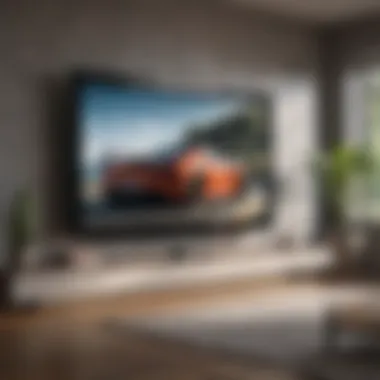The Ultimate Guide to Cleaning Big Screen TVs Effectively


Intro
Cleaning big screen televisions is a task that often goes overlooked, despite its significance in preserving image quality. Over time, dust, fingerprints, and smudges accumulate on the screen, detracting from the visual experience. However, using improper cleaning methods or materials can lead to damage. Thus, understanding how to properly clean and maintain a television screen becomes essential for viewers who want to enjoy a crystal-clear picture.
This guide will delve into various types of cleaners available on the market today. It will explore their effectiveness, proper application techniques, and the specific needs for different screen types, such as OLED, LED, and LCD. By the end of this article, readers will gain insights into maintaining their televisions’ clarity, optimizing longevity, and establishing a routine for care that enhances their overall viewing experience.
Understanding Screen Types
Before selecting a cleaner, it is vital to understand the television category one owns. Each screen type has distinct characteristics and cleaning requirements.
OLED Screens
Organic Light Emitting Diodes (OLED) offer vibrant colors and deep blacks, but they require gentle care. Avoid cleaners that contain ammonia as they can damage the panel. Opt for soft, lint-free microfiber cloths that are designed specifically for electronics.
LED Screens
Light Emitting Diode displays are more durable than OLED but still need careful handling. A mild solution of distilled water and white vinegar in equal parts usually suffices. Here, again, microfiber cloths are essential; they should be dampened, not wet, to prevent moisture from seeping into the edges of the screen.
Screens
Liquid Crystal Display televisions are the most common type. Similar to LED, these screens can suffer from scratches and streaks. Pre-moistened cleaning wipes specifically designed for LCDs are available, or one can create a solution of gently diluted soap and water.
Types of Cleaners
There are multiple cleaning products available for big screens, but not all are suitable for comprehensive care. Here are some popular options:
- Pre-moistened Wipes: Convenient for quick clean-ups and generally safe for most types.
- Spray Cleaners: Often contain additives for streak-free cleaning but read labels for compatibility.
- DIY Solutions: A mix of distilled water and vinegar can be effective but must be applied correctly.
Choosing the right cleaner greatly affects both clarity and longevity of the screen).
Best Practices for Cleaning
To avoid common pitfalls while cleaning a big screen TV, here are some recommended practices:
- Turn off the TV: Cleaning a powered-on screen can create glare, making it harder to see dirt and potentially dangerous.
- Use the right cloth: A microfiber cloth resists scratching and lint.
- Apply cleaner correctly: Never spray cleaners directly on the screen. Instead, spray it onto the cloth first.
- Gentle circular motion: This method prevents streaking and ensures a more thorough clean.
- Regular Maintenance: Establish a cleaning routine to keep the screen clear of dirt and dust.
Following these steps will not only enhance one's viewing experience but also extend the life of the television.
Ending
Taking care of a big screen TV involves understanding its specific requirements and employing the right methods and products. This guide has provided crucial insights into choosing the appropriate cleaners and maintaining screen clarity. As technology continues to evolve, embracing best practices in care will enable every viewer, from casual watchers to enthusiasts, to enjoy an optimal visual experience.
Understanding Big Screen TVs
Understanding the characteristics of big screen televisions is critical for anyone interested in maintaining their quality and longevity. With the rapid development of television technology, knowing the differences between various types can significantly influence decisions related to cleaning and care. A misstep in cleaning can lead to permanent damage, thus making this knowledge essential.
The Evolution of Television Technology
Over the decades, television technology has undergone transformations that have changed the way we watch and interact with media. From the bulky cathode-ray tubes to the sleek panels we see today, each generation has brought improvements in display quality, size, and energy efficiency. The introduction of HD, 4K, and now 8K resolution has set a new standard for picture quality. As televisions have grown in size, so too have the challenges associated with keeping them clean and maintaining their performance. Today, it is crucial to comprehend not just the history, but also the advancements that have led to the current options available.
Types of Big Screen TVs
Different types of big screen TVs are on the market, and each type presents distinct features that impact cleaning methods and maintenance practices.
LCD, or Liquid Crystal Display, is widely recognized for its affordability and decent picture quality. One key characteristic of LCD screens is their ability to produce sharp images with low power consumption. This makes them a popular choice among budget-conscious consumers. However, LCD screens can be susceptible to screen burn-in and may lose color accuracy over time. For cleaning, gentle solutions that do not contain ammonia are advisable to prevent damage to the screen.
LED
LED, which stands for Light Emitting Diode, is essentially an enhanced form of LCD. With remarkable brightness and energy efficiency, LED TVs have become a favored option in many homes. The unique feature of LED technology is the backlighting system that enhances color contrast, which provides an enriched viewing experience. Though they are less prone to certain issues like burn-in, the surface can still attract dust and smudges, necessitating proper cleaning techniques to maintain clarity and brightness.
OLED
Organic Light Emitting Diode (OLED) televisions represent a significant advancement in picture quality. Their ability to produce deep blacks and vibrant colors is unparalleled. The main advantage of OLED is that each pixel generates its own light, allowing for exceptional contrast ratios. However, caution is necessary during cleaning, as the screens can be more vulnerable to scratches. Using specific cleaning agents that are gentle on surfaces is essential to avoid compromising the display.
PLASMA
Plasma televisions, while less popular today, provided excellent color accuracy and viewing angles. Their distinct characteristic is the use of ionized gas to produce images, which results in stunning visual quality. Nonetheless, plasma screens can be heavy and may develop screen burn-in issues with static images. Cleaning these screens requires specialized knowledge to ensure longevity and functionality, so an understanding of their attributes is beneficial for any owner.
Understanding the different types of big screen televisions allows consumers to make educated choices regarding their cleaning and maintenance. It emphasizes the importance of using appropriate products and techniques tailored to the specific technology in their living spaces.
Importance of Cleaning Your Screen
Cleaning a big screen TV is not just about aesthetics; it holds considerable significance for the functionality and longevity of the device. Dust accumulation and smudges can obscure the sharpness and brilliance of the displayed image. Over time, neglecting this aspect can lead to irreversible damage. Maintaining a clean TV screen contributes to an enhanced viewing experience, unlike cluttered visuals that can detract from image clarity.
Moreover, keeping the screen clean prevents the buildup of grime that can harbor bacteria. Regularly cleaning your TV can thus promote a healthier viewing environment, which is especially pertinent in household settings where multiple individuals gather.
In a world where visual experience is paramount, the importance of effective screen cleaning cannot be overstated. Below we explore the singular impacts of dust and smudges on your television's appearance and performance.
Impact of Dust and Smudges


Dust and smudges are ubiquitous in any living space. For big screen TVs, these contaminants accumulate on the screen, leading to numerous drawbacks. When light reflects off a dusty or smudged surface, it creates a haze that muddles the viewing experience. This haze can detract from the colors and saturation of your favorite movies or sports events. Furthermore, persistent dust can scratch the screen when wiped improperly, causing permanent damage.
Another factor to consider is how the types of content viewed can influence this issue. For example, while watching dark scenes, dust and smudges can make details less visible, detracting from storytelling and immersion. By simply maintaining a clean screen, the vibrancy of colors and details comes to life, fostering a more enjoyable engagement with the content.
"A clean screen not only enhances visibility but also extends the life of the technology behind your television."
Maintaining Picture Quality
To appreciate high-definition content fully, maintaining picture quality is key, and this directly relates to the screen's cleanliness. An unclean screen can result in dull pictures and improper color representation. Dust can scatter light, while smudges can cause reflection issues that compromise the viewer's experience.
The requirement of clarity extends beyond merely keeping the screen visually appealing. Technology is sensitive. Many high-end televisions, such as OLED types, have delicate surfaces that can be adversely affected by improper cleaning techniques or materials. Regular attention to screen cleanliness ensures that these devices perform optimally, safeguarding the investment made in high-quality display technology.
Maintaining picture quality also embodies a less tangible benefit: the immersive experience provided by stunning visuals. Clean screens are pivotal for enhancing detail and contrast. A commitment to cleanliness fosters an appreciation for the artwork involved in film making, enabling viewers to engage with each scene at its best quality.
Types of Big Screen TV Cleaners
Understanding the various types of cleaners designed specifically for big screen TVs is paramount. Each cleaner has unique properties and intended uses, affecting how well it performs in maintaining your screen's clarity and longevity. The right cleaner can effectively remove dirt and smudges without damaging the delicate surface of your television.
Pre-Made Cleaning Solutions
Pre-made cleaning solutions are commercially available products that offer convenience for users. They often come in spray bottles and are designed specifically for different screen types. These cleaners typically include a mixture of water, alcohol, and other cleaning agents, ensuring they are safe for electronic screens. The main advantage is their ease of use, as users can quickly spray and wipe without needing to worry about creating the right mixture themselves.
However, it is crucial to choose a reputable brand. Many generic products may contain harsh chemicals that can damage your screen. Hence, reading reviews and checking for compatibility with your specific type of TV is advisable.
DIY Cleaning Solutions
DIY cleaning solutions provide an appealing alternative for those who prefer to create their own cleaning products at home. These solutions are often cost-effective and allow for greater control over the ingredients used.
Water and Vinegar Mixture
The water and vinegar mixture is one of the simplest and most popular DIY cleaning solutions. This mixture is praised for its effectiveness in removing smudges and fingerprints from screens without leaving streaks behind. The key characteristic of this solution is its natural ingredients, making it a safe choice for daily use.
One significant advantage is its accessibility; most households already have vinegar and water on hand. However, users must ensure a proper dilution ratio—usually a 50/50 mix—to prevent any sticky residues from lingering after cleaning.
Furthermore, while vinegar is effective, some screens may have protective coatings that vinegar can affect over time. It is wise to test this mixture on a small area first to ensure compatibility with the screen's surface.
Isopropyl Alcohol Solution
The Isopropyl Alcohol Solution is another well-known DIY option. Isopropyl alcohol is effective in breaking down oils and grime, making it an excellent choice for deeper cleans. It is particularly suited for screens that are heavily used, as it can tackle stubborn stains that may not come off with other solutions.
The main advantage of using isopropyl alcohol is its fast evaporation rate, which means it dries quickly and reduces the chance of moisture damage to sensitive components. A common recipe involves mixing equal parts of isopropyl alcohol and distilled water, creating a solution that is both effective and safe for most screen types.
Nevertheless, users must approach this solution with caution. Prolonged use can lead to screen damage or discoloration, particularly on sensitive OLED screens. Thus, one should check their manufacturer's recommendations before using isopropyl alcohol.
Materials for Cleaning
Cleaning your big screen TV effectively requires the right materials. Choosing proper cleaning tools can greatly affect the outcome of your efforts, ensuring that your screen remains clear and damage-free. Different materials serve distinct purposes and have unique characteristics that contribute to a good cleaning process.
Using unsuitable items can lead to scratches or smudges, compromising your viewing experience. Thus, understanding the importance of selecting the right materials becomes essential for maintaining the longevity and quality of your display.
Microfiber Cloths
Microfiber cloths are at the top of the list when it comes to cleaning materials for big screen TVs. They are designed to trap dust and dirt effectively.
One key characteristic is their softness. This ensures that the screen’s surface isn't scratched during the cleaning process. They are also highly absorbent, making them excellent for lifting oils and fingerprints without needing excessive liquid. Additionally, these cloths are reusable and washable, providing an eco-friendly option compared to disposable alternatives.
However, it is essential to ensure that these cloths are clean before use to avoid spreading dirt. Overall, microfiber cloths are a popular choice, as they effectively clean and maintain the integrity of the screen.
Spray Bottles
Spray bottles are an essential tool when applying cleaning solutions. They allow for a controlled distribution of liquid, preventing over-saturation and reducing the risk of damage to electronics.
A notable benefit is that they can hold various solutions, including DIY mixtures and commercial cleaners. The fine mist feature helps in delivering just the right amount of cleaner, which enhances the cleaning efficiency. However, it is crucial to ensure that the spray nozzle is set to mist rather than stream, as too much liquid can seep into crevices and harm internal components.
Other Cleaning Tools
Cotton Swabs
Cotton swabs serve a specific purpose when cleaning hard-to-reach areas. Their small size allows for precision, making them ideal for cleaning around buttons and edges without damaging the screen.
One key advantage of cotton swabs is their softness, which reduces the risk of scratching the surface. They can be used with cleaning solutions for spot cleaning, effectively targeting areas that need attention. However, it’s essential to take care not to push too hard, as excessive force could potentially scratch the surface. Overall, cotton swabs are a beneficial choice for detailed cleaning tasks.
Brushes
Brushes can be very helpful in maintaining big screen TVs, especially for dusting off surfaces gently. The bristles should be soft to avoid scratching. This characteristic makes them ideal for handling larger flat areas where dust tends to accumulate.
Brushes can reach into nooks and crannies that cloths may not effectively clean. Despite their benefits, one disadvantage is the difficulty of ensuring they stay free of debris, which could lead to scratching if used without care. Therefore, users should confirm that brushes are clean before each use. Brushes provide a practical means of keeping your TV clean and can supplement other cleaning materials.
Best Practices for Cleaning
Cleaning big screen TVs requires careful attention to detail and specific techniques. Following best practices ensures that your screen remains in optimal condition and that you avoid common pitfalls that can damage it. This section will cover essential guidelines that should be part of your cleaning routine.


Power Off Your Television
Powering off your television before cleaning is crucial. It not only protects your device but also improves visibility of smudges and dust on the screen. When the screen is off, reflections are reduced, allowing you to see more clearly where the dirt is located. Furthermore, it minimizes the risk of accidentally activating features or changing settings while attempting to clean. This simple step makes your cleaning more effective and thorough.
Use Gentle Pressure
Applying gentle pressure when cleaning is vital. Screens are delicate and can easily be scratched or damaged with too much force. Instead of scrubbing aggressively, use a light touch to wipe the surface. This allows you to remove dust and grime without compromising the integrity of the screen. In this context, the type of cloth used can also make a significant difference. Soft microfiber cloths are preferable as they are designed to clean without scratching the surface.
Avoid Certain Substances
Cleaning products can have differing effects on big screen TVs, and it's important to identify which substances to avoid.
Ammonia
Ammonia-based cleaners are often effective for regular household cleaning tasks, but they can be harmful to televisions. The key characteristic of ammonia is its strong chemical nature, which can lead to screen degradation. While it may be a popular choice for cleaning mirrors and windows, its use on screens can risk damaging the protective coating, negatively affecting picture quality over time. If you want to maintain the longevity of your TV, steer clear of ammonia.
Paper Towels
Paper towels are commonly found in many households as a cleaning tool due to their convenience. However, they can cause more harm than good when applied to screen cleaning. The key disadvantage of paper towels is their abrasiveness. Even though they may seem safe, they can create micro-scratches on the screen surface, which can accumulate and produce a hazy appearance. It is advisable to choose materials that are specifically designed for delicate surfaces, such as microfiber, instead.
Harsh Chemicals
Using harsh chemicals poses a significant risk to your TV. These substances can strip away the protective coatings on screens, rendering them vulnerable to damage. While harsh chemicals might offer quick cleaning results, the long-term consequences can be detrimental. As a general rule, it is important to select cleaners that are labeled safe for screen use or to consider homemade solutions that are gentle and effective.
Summary Point: Cleaning your big screen TV requires attention to detail. Power off the device, be gentle when cleaning, and avoid substances like ammonia, paper towels, and harsh chemicals to maintain the screen's integrity.
Common Mistakes in Cleaning
Cleaning big screen TVs can be more complex than it seems at first glance. Many individuals approach this essential maintenance task with a set of techniques that are not only ineffective but can also lead to damage. Understanding common mistakes in cleaning is vital to preserve the longevity and performance of your screen. This section explores several critical missteps that should be avoided when cleaning your TV to maintain its quality and appearance.
Using Incorrect Cleaner Types
One of the most significant errors people make when cleaning their big screen TVs is choosing unsuitable cleaning products. Many household cleaners contain ammonia or harsh chemicals. These substances can alter the screen coating, leading to permanent damage.
Using a cleaner that is not specifically designed for electronic screens can cause streaks or even degrade the display quality. It is imperative to choose cleaning solutions that are safe for your specific TV type, whether it is LCD, LED, OLED, or Plasma. Ultimately, checking the manufacturer’s guidelines will help determine the right cleaning solution for your device.
Scrubbing the Screen
Another common mistake is scrubbing the screen with excessive pressure. Many individuals think that vigorous cleaning will effectively remove dirt or fingerprints. However, this is not the case.
Applying too much pressure can lead to scratches or even screen damage. Instead, it is advisable to use a gentle, circular motion with an appropriate microfiber cloth to remove dust and smudges. By being more cautious, you can maintain the integrity of the screen while still achieving effective cleaning results.
Improper Cloth Choices
The choice of cloth can significantly impact how well you clean the screen. People often resort to using paper towels or other non-specialized fabrics, which can leave scratches or residues.
A microfiber cloth is generally preferred because it is soft and designed not to scratch surfaces. It can effectively trap dust and lift oils without damaging the screen. It is essential to replace these cloths regularly to avoid using ones that may have picked up dirt or grit.
"In cleaning, less is often more. Choosing the right tools can make all the difference."
Avoiding these common mistakes while cleaning your big screen TV can lead to a clearer picture and a longer-lasting device. Always be mindful of the products and methods you use to ensure optimal maintenance.
The Role of Manufacturer Guidelines
Manufacturer guidelines play a crucial role in maintaining the quality and longevity of your big screen television. These guidelines are provided by the makers of the television set and are based on extensive research and various testing conditions. Knowing and following these instructions can prevent potential damages that may arise from improper cleaning techniques or products. Furthermore, adhering to manufacturer guidelines protects warranty coverage, which can be critical if issues arise with your device.
One key element of these guidelines is the recommendation for specific cleaning products. Manufacturers often suggest gentle cleaners that effectively remove dust and smudges without causing harm to screen coatings. Ignoring these recommendations can lead to issues, including streaks, discoloration, or even irreversible damage to the screen's surface.
Another vital aspect is understanding the cleaning methods that are safe for each screen type. Different display technologies, such as LCD, LED, OLED, or Plasma, may require tailored approaches. The guidelines provide details on what tools to use, such as the type of cloth that should be utilized to prevent scratches and what cleaning agents to avoid, ensuring that the integrity of the display is preserved.
"Following manufacturer guidelines will help maintain the performance and appearance of your big screen TV for years to come."
It is essential to consult the user manual or the manufacturer's website to find the latest recommendations. Additionally, reaching out to customer service can clarify any uncertainties related to cleaning and maintenance. Having a position on these guidelines provides reassurance to users regarding their appliance care.
Understanding Warranty Implications
Reading the manufacturer's warranty is essential before cleaning your TV. Many warranties include specific clauses regarding proper maintenance. If these guidelines are not followed, it can lead to the warranty being voided in cases of damage. Therefore, recognizing what is covered and what actions are permitted will save users a lot of trouble later. For instance, if a screen gets damaged due to the use of harsh chemicals, the manufacturer might not honor warranty claims. It is advisable to be cautious and meticulous in how the cleaning is approached.
Following Specific Recommendations
Every television model comes with its specific guidelines regarding cleaning. These recommendations are typically found in the manual or on the official manufacturer's website. Cleaning solutions, materials, and techniques recommended by manufacturers are backed by tests for safety and effectiveness. Thus, it is beneficial to adhere to them strictly. Following these specific recommendations strengthens the likelihood of maintaining optimal screen clarity and prolonging the life of the television.
Commonly recommended practices include:
- Avoiding ammonia-based cleaners.
- Using a microfiber cloth to prevent scratches.
- Employing gentle, circular motions when cleaning the screen.
Incorporating this knowledge into your routine will enhance the viewing experience and optimize the investment you have made in a big screen television.
Special Considerations for Different Screen Types
Cleaning methods can differ based on the type of big screen television. Each screen technology has unique needs that require special attention. This section will delve into the specific cleaning considerations for LCD, LED, OLED, and plasma screens. Understanding these nuances is crucial to maintaining the integrity and performance of the television.


Cleaning Screens
LCD screens are generally more durable than their OLED counterparts but still require careful handling. When cleaning an LCD screen, it is essential to avoid harsh chemicals that can damage the panel. Most LCD screens can be cleaned using a gently damp microfiber cloth.
- Power off the TV to prevent any electrical issues.
- Use a solution of distilled water mixed with a small amount of mild dish soap if necessary.
- Dampen the cloth lightly, ensuring it is not saturated.
- Wipe the screen in gentle circular motions.
This method will help maintain clarity without risking damage to the delicate layers of the screen.
Cleaning LED Screens
LED screens function similarly to LCDs but incorporate a backlighting system that provides a more vibrant display. The cleaning process is similar but with one crucial difference.
- Always clean with a dry microfiber cloth first to remove dust.
- Follow this by using a slightly dampened cloth to avoid streaks.
While LED screens can resist smudges better than LCDs, it is still important to treat them gently to avoid any deterioration in quality.
Cleaning OLED Screens
OLED screens offer superior picture quality but are notably more sensitive to certain cleaning products and techniques.
For OLED screens, consider the following:
- Power off the device to prevent accidental damage.
- Use only a soft microfiber cloth damp with water or a specialized cleaner.
- Avoid pressure while cleaning, as the organic material in OLED screens can be damaged easily.
Taking care to follow these steps can enhance the longevity of the screen and maintain its exceptional picture quality.
Cleaning Plasma Screens
Plasma screens are less common today but still found in many households. The cleaning process for plasma screens is unique due to their susceptibility to burn-in.
- Use a dry microfiber cloth to gently dust the screen.
- If necessary, a slightly dampened cloth can be used, but be careful not to let moisture seep into the edges.
- Avoid using any products with ammonia or strong chemicals, as these can damage the screen surface.
Environmental Impact of Cleaning Products
The topic of environmental impact of cleaning products is increasingly relevant as consumers become more aware of their ecological footprint. With the rise of sustainability movements, many individuals are now seeking ways to maintain their homes without compromising the environment. This includes the products they use to clean their big screen TVs. Utilizing cleaning agents that are harsh on the environment can lead to pollution and health risks. It is essential to consider both the ingredients within these products and their eventual disposal.
Eco-friendly cleaning products often contain biodegradable ingredients, which break down naturally in the environment. These products minimize the presence of chemicals that can harm local wildlife and ecosystems. Moreover, opting for sustainable options can significantly reduce the carbon footprint associated with mass-produced cleaners, which often require extensive resources for manufacturing and packaging. As a result, selecting environmentally safe cleaners not only contributes positively to the planet but also promotes a healthier living space for individuals.
Understanding Eco-Friendly Options
When it comes to cleaning big screen TVs, there are several eco-friendly options available. Many brands have started producing cleaners that are free from phosphates, solvents, and other harmful substances. Look for cleaners that are labeled as non-toxic, organic, or environmentally friendly. These products often use safer compounds derived from natural sources, such as plant-based materials.
A few popular eco-friendly brands include:
- Ecos
- Method
- Seventh Generation
In addition to commercial products, simple DIY cleaners can also be effective and environmentally safe. Solutions such as vinegar mixed with water can serve as a gentle cleaner for screens. This not only avoids synthetic chemicals but also promotes resourcefulness at home.
Disposing of Cleaners Responsibly
Disposing of cleaning products correctly is crucial for minimizing their environmental impact. Many conventional cleaners contain hazardous chemicals that can contaminate water supplies and soil if not disposed of properly. To mitigate this, consider the following practices for responsible disposal:
- Follow Local Guidelines: Check with local waste management facilities to learn how to dispose of different types of cleaners.
- Return Programs: Some retailers offer take-back programs for cleaning products, allowing consumers to return empty containers for safe disposal.
- Avoid Pouring Down Drains: Never pour chemicals down the sink or toilet, as they can harm the plumbing and the environment.
Ensuring responsible disposal of cleaning products aligns with eco-conscious choices and promotes healthier environments for future generations. By understanding and applying these principles, individuals can play a part in reducing waste and protecting ecosystems while maintaining their big screen TVs.
The Future of Cleaning Technology
As technology evolves, so too does the way we care for our possessions, including big screen televisions. The future of cleaning technology for TVs presents new opportunities to enhance the maintenance experience. With the increasing complexity of screen technologies—like OLED and LED—specific cleaning technologies that cater to these advancements are crucial.
Innovations in Screen Care
Innovative solutions are emerging that promise to revolutionize how we clean our screens. Some cleaning products are now being developed with smart formulas, specifically designed to minimize streaks and reduce static build-up. These innovations help to maintain picture quality while providing a better overall cleaning experience. Additionally, new microfiber materials are being engineered to be more effective at trapping dust and dirt without damaging sensitive screen surfaces.
Another noteworthy advancement is the creation of cleaning sprays that are not only effective but also environmentally safe. Many manufacturers are focusing on eco-friendly formulations. This shift reflects a growing awareness of the environmental impact of cleaning agents and the need for sustainable alternatives.
"The future of screen care is not only about keeping TVs clean but also about safeguarding the environment."
Smart Cleaning Devices
The rise of smart technology has led to the development of automated cleaning devices tailored for electronics. These devices often incorporate AI to assess the level of dirt and smudges on the screen, adjusting their cleaning methods accordingly. For instance, some robotic cleaning devices can move over the screen, using gentle suction or microfiber pads to remove dust and fingerprints without user intervention. This is particularly beneficial for larger screens or for those who may find traditional cleaning methods cumbersome.
Furthermore, integration with smart home systems allows these devices to be programmed for routine cleaning, setting a schedule that can align with viewing habits. Users can simply activate the device via a smartphone app or voice command, ensuring that the screen remains spotless without much effort.
As the technology advances, it will also likely feature self-cleaning capabilities that could cover all aspects of television maintenance, extending beyond just the screen to include the surrounding units and mounts.
In summary, the future of cleaning technology for big screen TVs indicates a shift toward more efficient, effective, and environmentally friendly options, creating a new standard for screen care that meets contemporary needs.
Closure
Cleaning big screen TVs is an essential task for maintaining both the quality of the picture and the overall lifespan of the device. This article provided an in-depth look at various aspects of cleaning, focusing on effective cleaners, appropriate techniques, and materials required for optimal care. The significance of understanding how to clean your big screen is underscored by the potential impacts dust and smudges can have on viewing quality. Regular maintenance not only enhances the visual experience but also prevents damage that could lead to costly repairs or replacements.
Summarizing Key Points
In summary, several key points emerge from the discussion:
- Types of Cleaners: A variety of cleaning solutions exist, including pre-made options and DIY mixtures, allowing users to choose depending on their preferences and values.
- Correct Materials: Using the right cloths and tools is crucial. Microfiber cloths are highly recommended due to their effectiveness in trapping dust without scratching the surface.
- Best Practices: Some fundamental cleaning habits include turning off the TV before cleaning, applying gentle pressure, and avoiding harsh chemicals that can degrade the screen.
- Common Mistakes: Awareness of frequent errors, such as using incorrect cleaners or scrubbing too hard, can prevent damage and improve cleaning efficacy.
- Environmental Considerations: The impact of cleaning products on the environment should be taken into account, guiding users towards more eco-friendly options.















